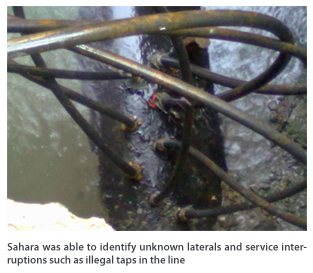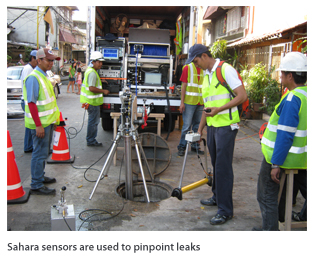Manila, Philippines, Leak Detection Program Uses Tethered In-Line Leak Detection System
April 27, 2011
 Pure Technologies, under a past contract through wholly owned subsidiary Pressure Pipe Inspection Co. (PPIC), recently conducted a leak detection program for the Maynilad Water Service in Manila, Philippines.
Pure Technologies, under a past contract through wholly owned subsidiary Pressure Pipe Inspection Co. (PPIC), recently conducted a leak detection program for the Maynilad Water Service in Manila, Philippines.Maynilad is the water and wastewater services provider for 17 cities and municipalities that comprise the West Zone of the greater Metro Manila area. The work included the use of Sahara leak detection, in addition to video inspection on a major pipeline system. The technology detected a variety of leaks that were then repaired and vital water distribution restored.
The leaks were not visible from the surface and presumably had been leaking for a long period of time. Unknown laterals, which contribute to water loss, were likewise successfully identified and located using a video camera during inspection. Other water losses detected included service interruptions such as connections tapped on a primary line, either illegal connections or old service connections that were unaccounted for. Maynilad operates a pipeline network that runs for more than 6,000 km.
The initial contract between PPIC and Maynilad was signed in 2009 as part of a strategic water loss management program aimed at reducing non-revenue water loss. Under this contract, Maynilad engineers were trained on Sahara technology so they could operate the equipment in the West Zone concession. The initial contract was extended twice with Maynilad water Services. Sahara leak detection system is optimal for urban centers such as Manila that have complex interconnecting networks. The tethered cable provides a high degree of operator control with inspection results provided in real time. Sahara is a versatile tool with a variety of configurations capable of detecting leaks, providing CCTV inspection, and measuring average wall thickness.
The leak detection program allows the client to establish the condition of their pipeline in order to optimize repair and replacement programs and maintain vital supply to customers. Since the start of the program, 50 miles were inspected with more than 157 leaks located and 79 illegal conections or unknown laterals identified.
This article was supplied by Pure Technologies.
What Is the Sahara Leak Detection System?
 The Sahara leak detection system is an accurate tool for detecting leaks and pockets of trapped gas in large diameter water and wastewater mains. Effective in pipelines of all materials and diameters, Sahara is a critical component of condition assessment and water loss management programs for utilities throughout the world. Sahara has had and continues to have great success in Manila, Philippines. Sahara has greatly contributed to Maynilad’s Non Revenue Water (NRW) reduction program.
The Sahara leak detection system is an accurate tool for detecting leaks and pockets of trapped gas in large diameter water and wastewater mains. Effective in pipelines of all materials and diameters, Sahara is a critical component of condition assessment and water loss management programs for utilities throughout the world. Sahara has had and continues to have great success in Manila, Philippines. Sahara has greatly contributed to Maynilad’s Non Revenue Water (NRW) reduction program.Sahara pipeline inspections are conducted while the main remains in service by inserting a sensor into any tap 2 in. or larger. A small parachute uses the flow of water to draw the sensor through the pipeline. The sensor is tethered to the surface, allowing for real-time results and maximum control and sensitivity. The surface tracking device allows the position of leaks and other pipeline features to be located to within 18 in. Depending on pipeline features and flow velocity, Inspection distance can go up to 2 km. Sahara video, which uses a video head instead of a leak detection head, allows CCTV inspections on pipelines while they remain in service, Sahara video has been used to assess the conditions of pipeline interiors, locate known features with unknown locations, and locate unknown features including illegal taps along the inspected pipelines.



